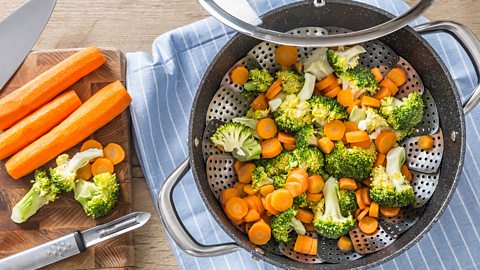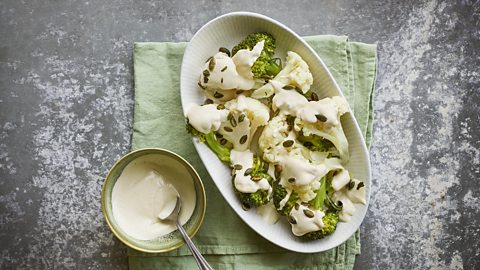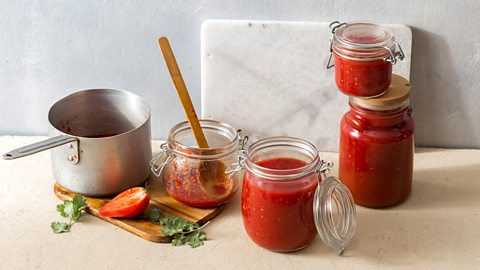What’s the healthiest way to cook vegetables?
Does the way you prepare your vegetables make a difference to their nutritional content? Are some vegetables best eaten raw? Here’s dietitian, Tai Ibitoye’s advice…
By Tai Ibitoye

When looking at ways to improve our diet, it can be hard to navigate the conflicting advice online. But one thing we can all agree on is that vegetables are an integral part of a healthy, balanced diet.They’re excellent sources of vitamins, minerals, phytochemicals and fibre, all of which are good for our health.
Many studies have shown that diets rich in vegetables are associated with a lower risk of long-term chronic health conditions, such as cardiovascular disease.
But can the way you cook your vegetables change the level of nutrients you get from them? Here’s what you need to know…
Boiling
It’s one of the most common cooking methods, but it comes with some shortcomings. The biggest issue is that boiling vegetables can reduce their vitamin C content. This happens because the key vitamin that helps support our immune system is water soluble and sensitive to the effects of heat and water. This means that the vitamin leaches out of the vegetables and into the cooking water.
One study looked at six vegetables and analysed how various cooking methods impacted their nutritional content. They found that boiling carrots, pumpkin, peas and spinach for six minutes led to the most significant reduction in vitamin C content of all cooking methods, with some of the vegetables losing up to 70% of vitamin C. Spinach showed the highest reduction.
This has also been seen in another study, where boiling led to roughly 55% vitamin C retention in carrots, 53% in broccoli and 0% vitamin C in boiled chard. Further research is necessary to explain why there’s a greater loss of vitamin C in some vegetables compared to others.
In addition to losing vitamin C, the content of minerals like potassium, magnesium and zinc are typically lower in boiled vegetables compared to raw vegetables.
This doesn’t apply to all minerals though, with calcium and iron potentially increasing in some vegetables like spinach, when boiled. This may be due to the binding of other food compounds which prevent the release of these minerals into the cooking water.
In contrast, there is some evidence to suggest that boiling may increase beta carotene (which converts into vitamin A when we eat it) in carrots. By softening the plant walls where the beta-carotene is, it’s more accessible to us.
If you’re keen on boiling vegetables but don’t want to lose the nutrients, then one option is to use the vegetable cooking water in the dish. This is a good option when cooking curries or stews. Also, using as little water as possible and avoiding overcooking can help minimise vitamin loss.
Veggie slow cooker curry
The stock used in this curry’s absorbed into the recipe and so will retain the vitamins that leech into it

Steaming
Steaming vegetables is popular with dietitians because you lose less vitamins than boiling. When steamed, vegetables like broccoli, spinach and lettuce lose just 9-15% of their vitamin C content.
One study also found that steaming showed the best retention of phytochemicals (which are thought to protect the immune system) compared to other cooking methods.
In addition, steaming ensures better preservation of glucosinolates, which are associated with having antioxidant effects and are found in broccoli, Brussels sprouts, cauliflower and cabbage.
Almost all vegetables can be steamed with good results and it may also enhance the flavour and texture. In particular, steaming root vegetables like artichoke and parsnips is said to provide a better sensory experience.
Steamed vegetables with tahini and yoghurt dressing
Pair your veg with this simple but refreshing dressing

Microwaving
Microwaving is a quick and convenient way to cook vegetables. There is some evidence showing microwaving can preserve nutrients like vitamin C and some phytochemicals in vegetables compared to other cooking methods.
In fact, one study showed microwaving spinach and carrots, allowed the vegetables to retain more than 90% of its vitamin C content. Primarily because the vegetables had limited contact with water and were cooked at lower temperatures.
There’s also evidence to suggest that microwaving some vegetables, including spinach and chard, helps to retain vitamin K, which is required for blood clotting and helping wounds to heal.
Try these microwave vegetable recipes
Roasting
Roasting is a great way to enhance flavour in vegetables as it helps release natural sugars. It’s also considered to be a good method of retaining vitamin B1 (thiamine) and vitamin B2 (riboflavin).
Priya Tew shows how to use roasted vegetables in three different ways
Roasting is also recommended as a way of cooking tomatoes as it can help increase the lycopene content in them. This is particularly valuable because lycopene is an antioxidant that is believed to protect cardiovascular health and is easily absorbed in the body when tomatoes are cooked (such as homemade tomato sauce or roasted tomatoes).
Roasting your vegetables is hard to beat for flavour, as these recipes demonstrate
Sautéing
Sautéing involves cooking in a shallow pan using high heat with a small amount of oil. And while it’s important to be aware of how much oil we consume (as it increases the calorie count), it could help when cooking tomatoes, with one study showing that adding olive oil to diced tomatoes during cooking in this way, greatly increased the absorption of lycopene.
What about not cooking them at all?
To get the largest amount of vitamin C, there are some vegetables that benefit from being eaten raw such as broccoli and lettuce.
However, some vegetables are more digestible and palatable when cooked. Cooking also releases some nutrients like carotenoids which, aren’t accessible when eaten raw.
Ultimately, cooking vegetables to your personal taste is better than not eating them at all. It is worth enjoying them in different forms to get the most from them nutritionally. So, if you decide to boil your vegetables one day, why not try a steamed vegetable recipe the next, or drizzling over some olive oil and roasting them the time after. That way you’ll get the most nutrients and a range of tastes and textures too.
Published May 2024



